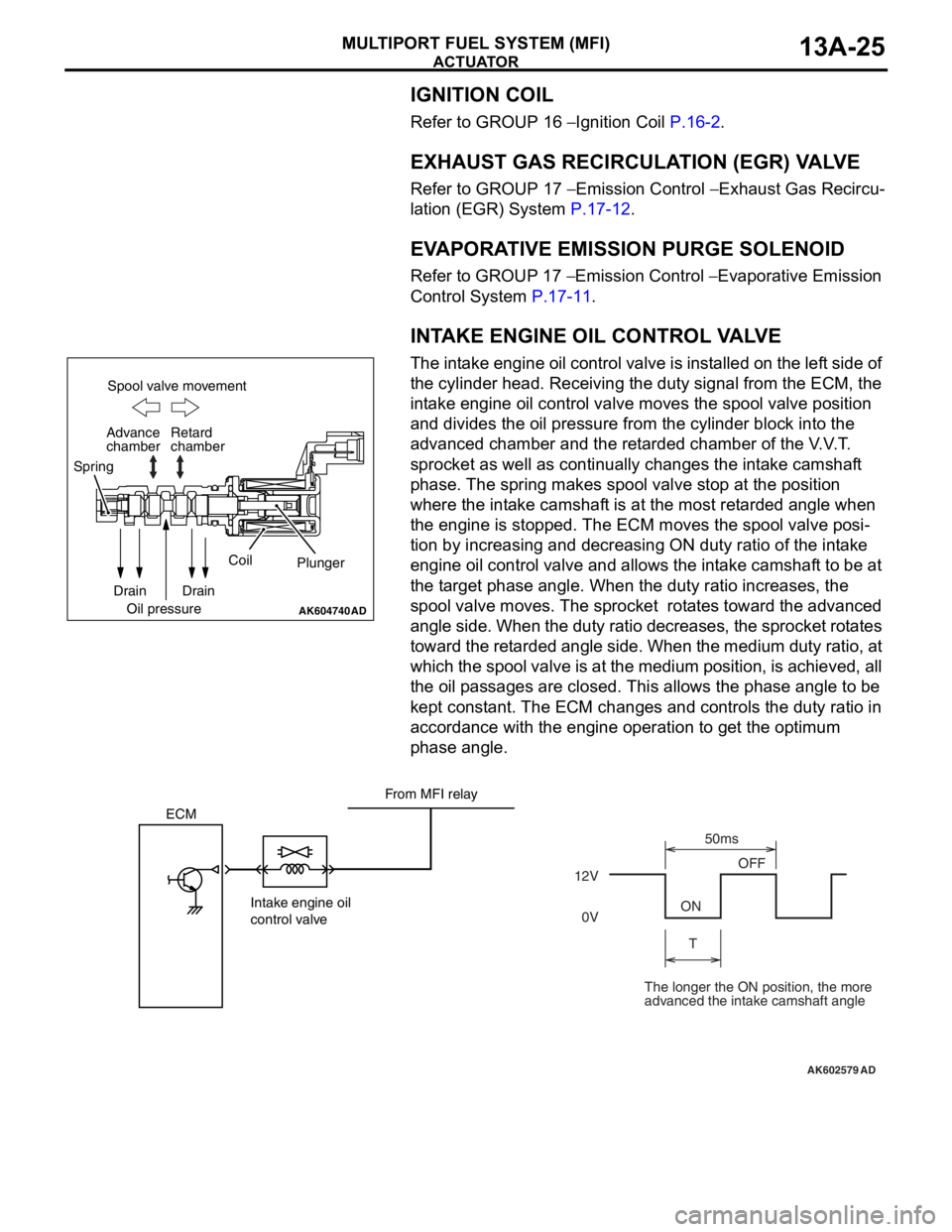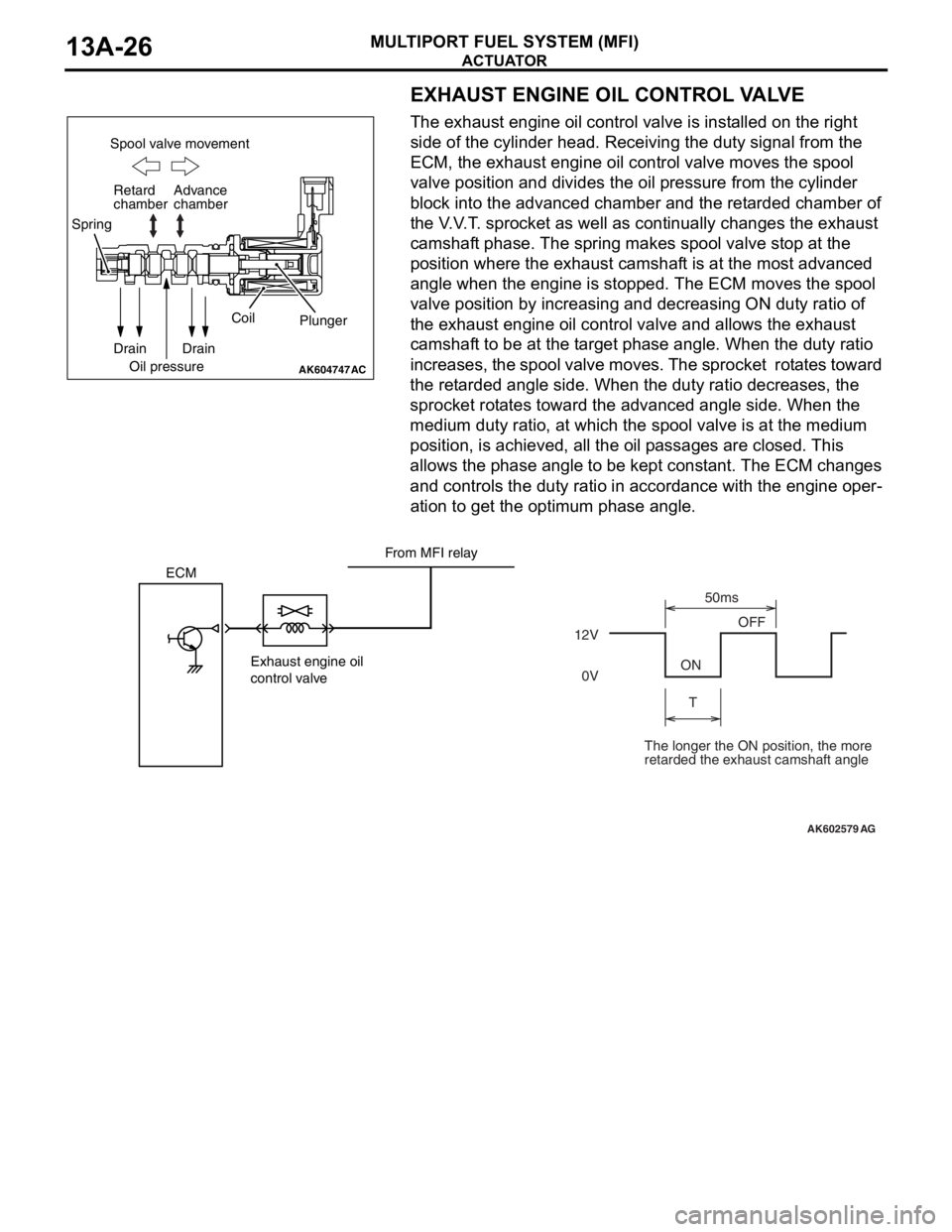2008 MITSUBISHI LANCER EVOLUTION X oil change
[x] Cancel search: oil changePage 74 of 241

EMISSION CONTROL
ENGINE AND EMISSION CONTROL17-12
EVAPORATIVE EMISSION PURGE SOLENOID
An evaporative emission purge solenoid is installed in the
intake manifold.The evaporative emission purge solenoid con
-
trols the intake volume of fuel vapor gas from the canister. The
evaporative emission purge solenoid is a duty control type
solenoid valve. When current is not passing through the coil,
nipple A is kept airtight and fuel vapor gas cannot be sucked in.
When current passes through the coil, air can pass between
nipple A and B and fuel vapor gas is sucked in. ECM changes
the ON duty ratio according to engine's operating condition to
control the intake volume of fuel vapor gas.
EXHAUST GAS RECIRCULATION (EGR) SYSTEM
When the combustion gas temperature becomes
high, generation of the environment polluting NOx
(nitrogen oxides) increases rapidly. EGR system is
used to decrease the volume of NOx generated.
EGR system re-circulates exhaust gas inside the
intake manifold. It increases specific heat of the com
-
bustion gases and reduces combustion speed to lower the combustion temperature and reduce the
volume of NOx generated. ECM calculates the EGR
introduction volume according to engine operating
conditions and controls the EGR valve opening angle
at optimum. Also, immediately after the ignition
switch ON signal is input, it drives fully closed step
-
per motor and performs initialization.
AK604745AC
B To canister
To intake manifoldA
AK602245AD
12V
ONOFF
0V100 ms
Evaporative
emission
purge solenoidFrom MFI relay
ECM
AK502987AE
ECMMass airflow sensor
Intake air temperature sensor
Manifold absolute
pressure sensor
Engine coolant
temperature sensor
Throttle position sensor
Crankshaft position sensor BatteryEGR valve
(stepper motor)
Page 75 of 241

EMISSION CONTROL
ENGINE AND EMISSION CONTROL17-13
EXHAUST GAS RECIRCULATION (EGR) VALVE
An EGR valve is installed in the EGR valve support.The EGR
valve controls EGR flow volume using the stepper motor
method and reduces exhaust gas (NOx) and fuel consumption.
The EGR valve drives the stepper motor based on the signal
from ECM. When stepper motor rotor turns in clockwise or
anti-clockwise direction, the shaft fitted with a rotor and a screw
expands and contracts and the movement of the shaft causes
the valve to go up and down. Thus, EGR path gap is controlled
minutely. The stepper motor turns 15
° per step. The stepper
motor turns forward or back only up to the angle dictated by the
number of pulse signals (number of steps) from the ECM. In
other words, increase and decrease of the EGR flow volume
depends on the number of signals (number of steps) from
ECM. ECM changes current flow to the 4 coils (A, B, C, D) in
the stepper motor in sequence according to the phase pattern
in the following chart in order to turn the stepper motor rotor.
Open valve changes phase in order of 0
→ 1 → 2 → 3 → 0. Close
valve changes phase in order of 3
→ 2 → 1 → 0 → 3.
Phase
numberStepper motor coil
Coil ACoil BCoil CCoil D
0ONOFFOFFON
1ONOFFONOFF
2OFFONONOFF
3OFFONOFFON
AK604144
Coil
Shaft
Valve Outlet
Inlet
Rotor
Magnet
AB
AK604145
From MFI relay
EGR valve
(stepper motor)
ECM Coil
ACoil
BCoil
CCoil
DFlow rate
Step
AB
Page 100 of 241

CONTROL UNIT
MULTIPORT FUEL SYSTEM (MFI)13A-6
CONTROL UNITM2132021500153
ENGINE CONTROL MODULE (ECM)
ECM is installed in the engine room. ECM judges
(calculates) the optimum control to deal with the con
-
stant minute changes in driving conditions based on
information input from the sensors and drives the
actuator. ECM is composed of 32-bit microprocessor
and Random Access Memory (RAM), Read Only
Memory (ROM) and Input /Output interface. ECM uses flash-memory ROM that allows re-writing of
data so that change and correction of control data is
possible using special tools. It also uses Electrically
Erasable Programmable Read Only Memory
(EEPROM) so that studied compensation data is not
deleted even if battery terminals are disconnected.
ECM CONNECTOR INPUT/OUTPUT PIN ARRANGEMENT
NOTE: *: California
AK604119
ECM
Microprocessor
RAM Input
interfaceOutput
interface Input
sensorOutput
actuator
AB
ROM
AK602565AC
1 2 3 4 5 6 7 8 9 10 11 1213 14 15 16
17 18 19 20 21 91
90
89
87
86
84 85
83 82
88 92 93 94
95 96 97 98 99
109
108
107 106
105
104
103
102
112 113 114 115 116 117 118
100 101
111
110
41
40
39
38
37
36
35
34
33 32
31
30
29
28
27
26
25
24
23
2260
59
58
57
56
55
54
53
52
51
50
49 48
47
46
45
44
43
4263
61 62 6471 72 73 74 75 76 77 78 79 80 81
1Intake engine oil control valve2No.1 injector
3No.2 injector4Ignition coil No.1 (ignition power transistor)
5Ignition coil No.2 (ignition power transistor)6Starter active signal
7Exhaust camshaft position sensor8Crankshaft position sensor
9Sensor supplied voltage10Throttle position sensor (main)
11Throttle position sensor (sub)12Power supply voltage applied to throttle
position sensor
13Throttle position sensor ground14Intake camshaft position sensor
Page 114 of 241

SENSOR
MULTIPORT FUEL SYSTEM (MFI)13A-21
.
GENERATOR FR TERMINAL
Generator turns ON/OFF the power transistor in the voltage
regulator to adjust current flow in the field coil according to
alternator output current. In this way generator's output voltage
is kept adjusted (to about 14.7 V). The ratio of power transistor
ON time (ON duty) is output from generator FR terminal to
ECM. ECM uses this signal to detect generator's output current
and drives throttle actuator control motor according to output
current (electric load). This prevents change in idle speed due
to electric load and helps maintain stable idle speed.
.
AK602229AD
FR BS
Field coil
IC regulator
GeneratorIgnition switch-IG
Battery
ECM
Page 117 of 241

ACTUATOR
MULTIPORT FUEL SYSTEM (MFI)13A-24
THROTTLE ACTUATOR CONTROL MOTOR
A throttle actuator control motor is installed in throttle body. The
throttle actuator control motor performs the Open/Close of the
throttle valve through the reduction gear. ECM changes current
direction according to the Open/Close direction and also
changes current to the motor coil to control the throttle actuator
control motor.
Throttle actuator control motor is composed of a good
response, low energy, and small DC motor with brush and can
generate rotation force corresponding to the current applied on
the coil. When there is no current passing through the throttle
actuator control motor, the throttle valve remains at a pre
-
scribed opening angle. So, even if current stops because of a
fault in the system, a minimum level of running remains possi
-
ble.
AK604125AB
Throttle body
Throttle actuator
control motor
AK602231
Throttle actuator
control motor
Throttle actuator
control motor relayMFI relay
To ECM
Power supplyOFFON
OFF
ON
AE
From battery
ECM
Page 118 of 241

ACTUATOR
MULTIPORT FUEL SYSTEM (MFI)13A-25
IGNITION COIL
Refer to GROUP 16 − Ignition Coil P.16-2.
EXHAUST GAS RECIRCULATION (EGR) VALVE
Refer to GROUP 17 − Emission Control − Exhaust Gas Recircu-
lation (EGR) System P.17-12.
EVAPORATIVE EMISSION PURGE SOLENOID
Refer to GROUP 17 − Emission Control − Evaporative Emission
Control System
P.17-11.
INTAKE ENGINE OIL CONTROL VALVE
The intake engine oil control valve is installed on the left side of
the cylinder head. Receiving the duty signal from the ECM, the
intake engine oil control valve moves the spool valve position
and divides the oil pressure from the cylinder block into the
advanced chamber and the retarded chamber of the V.V.T.
sprocket as well as continually changes the intake camshaft
phase. The spring makes spool valve stop at the position
where the intake camshaft is at the most retarded angle when
the engine is stopped. The ECM moves the spool valve posi
-
tion by increasing and decreasing ON duty ratio of the intake
engine oil control valve and allows the intake camshaft to be at
the target phase angle. When the duty ratio increases, the
spool valve moves. The sprocket rotates toward the advanced
angle side. When the duty ratio decreases, the sprocket rotates
toward the retarded angle side. When the medium duty ratio, at
which the spool valve is at the medium position, is achieved, all
the oil passages are closed. This allows the phase angle to be
kept constant. The ECM changes and controls the duty ratio in
accordance with the engine operation to get the optimum
phase angle.
AK604740AD
Spool valve movement
Retard
chamber
Spring
Drain
Oil pressureCoil
Plunger
Drain Advance
chamber
AK602579
ECM
Intake engine oil
control valve12VOFF
ON
T50ms
0V
AD
From MFI relay
The longer the ON position, the more
advanced the intake camshaft angle
Page 119 of 241

ACTUATOR
MULTIPORT FUEL SYSTEM (MFI)13A-26
EXHAUST ENGINE OIL CONTROL VALVE
The exhaust engine oil control valve is installed on the right
side of the cylinder head. Receiving the duty signal from the
ECM, the exhaust engine oil control valve moves the spool
valve position and divides the oil pressure from the cylinder
block into the advanced chamber and the retarded chamber of
the V.V.T. sprocket as well as continually changes the exhaust
camshaft phase. The spring makes spool valve stop at the
position where the exhaust camshaft is at the most advanced
angle when the engine is stopped. The ECM moves the spool
valve position by increasing and decreasing ON duty ratio of
the exhaust engine oil control valve and allows the exhaust
camshaft to be at the target phase angle. When the duty ratio
increases, the spool valve moves. The sprocket rotates toward
the retarded angle side. When the duty ratio decreases, the
sprocket rotates toward the advanced angle side. When the
medium duty ratio, at which the spool valve is at the medium
position, is achieved, all the oil passages are closed. This
allows the phase angle to be kept constant. The ECM changes
and controls the duty ratio in accordance with the engine oper
-
ation to get the optimum phase angle.
AK604747
Spool valve movement
Retard
chamber
Spring
Drain
Oil pressureCoil
Plunger
Drain Advance
chamber
AC
AK602579
ECM
Exhaust engine oil
control valve12VOFF
ON
T50ms
0V
AG
From MFI relay
The longer the ON position, the more
retarded the exhaust camshaft angle
Page 121 of 241

ACTUATOR
MULTIPORT FUEL SYSTEM (MFI)13A-28
GENERATOR G TERMINAL
ECM uses ON/OFF of generator G terminal to control genera-
tor output voltage. When the power transistor in the ECM turns
ON, output voltage gets adjusted to about 12.8 V. When gener
-
ator output voltage drops to 12.8 V it becomes lower than volt-
age of the charged battery and almost no current is output from
the generator. When the power transistor in the ECM turns
OFF, output voltage gets adjusted to about 14.7 V. When gen
-
erator output voltage is about 14.7 V, generator outputs current
to produce electricity. In case electric load is generated sud
-
denly, ECM controls generator G terminal's On-duty to limit the
sudden increase in generator load due to generation and thus
prevents change in idle speed.
AK602233AD
Field coil
IC regulator
GeneratorG Ignition switch-IG
Battery
BS
ECM